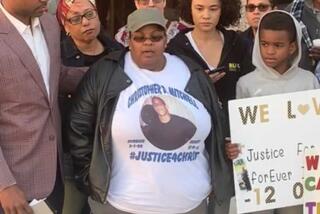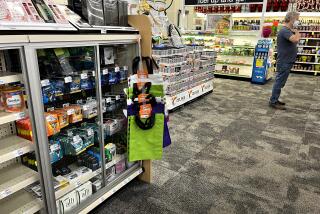REGIONAL REPORT : When Is Drunk Driving Murder? : Courts: Jurors are requiring a high degree of recklessness before returning homicide verdicts against intoxicated motorists.
- Share via
More than two years ago, a Ventura County bookkeeper named Diane Mannes was picked up in Van Nuys on suspicion of drunk driving. Police say her blood-alcohol level was 0.26%, more than twice the legal limit at the time.
The next night, after bailing out of jail, Mannes was back on the booze--and back on the road. As she made her way down the Ventura Freeway’s steep, curving Conejo Grade near Camarillo, she plowed into five youths walking away from their disabled car.
Three were killed in the March, 1989, crash, two were hurt and Mannes, whose blood-alcohol level this time was 0.20%, was charged with murder.
“If this is not a murder case, I haven’t seen one yet,” Ventura County Dist. Atty. Michael D. Bradbury said, adding that Mannes also had a 1983 conviction for driving under the influence.
The jurors who heard the case in November, 1989, convicted Mannes of drunk driving and causing great bodily injury to the youths who survived.
But they deadlocked on the murder charges, saying they disagreed on whether Mannes had exhibited the essential element that distinguishes murder from other homicides: malice aforethought.
The case, now being appealed on another issue, illustrates the challenge that California prosecutors face in getting murder convictions against drunk drivers.
In 1981, the California Supreme Court ruled that second-degree murder charges could be filed in traffic deaths, including deaths related to drunk driving. Despite the hopeful predictions of groups such as Mothers Against Drunk Driving--and dissenters on the Supreme Court, who feared a wave of such cases--prosecutors estimate that no more than 30 drunk drivers statewide have been convicted of murder since the ruling.
By contrast, more than 1,100 drunk drivers have been convicted of the lesser charge of vehicular manslaughter since 1984, when the attorney general’s office began keeping such statistics.
In the face of society’s apparent decreasing tolerance for drug- and alcohol-induced excesses--as evidenced by the lowering of the legal threshold for intoxication and the imposition of tougher penalties for repeat offenders--the reluctance of juries to convict a drunk driver of murder seems out of step.
“Society’s attitude toward drinking and driving has changed,” said Larry Diamond, a Los Angeles County deputy district attorney. “People are more conscious of the dangers.”
Then why haven’t there been more murder convictions?
For one thing, said David French, co-chairman of California MADD’s public policy committee, “It’s the ‘There but for the grace of God go I’ mentality.” Many jurors have been guilty of drunk driving themselves, he said.
The main reason, prosecutors say, is the high--though inexact--standard that the law poses for proving malice.
In her dissent of the Supreme Court ruling, former Chief Justice Rose Elizabeth Bird complained that the court was establishing “a new crime of second-degree murder for anyone who is involved in an accident . . . while under the influence of alcohol.”
Proof of intoxication, by itself, is not enough to show malice, said Dinko Bozanich, a Los Angeles County deputy district attorney who won the state’s first murder conviction under the ruling. Nor does it matter, as a general rule, how drunk a person is or how many prior drunk-driving convictions he has, Bozanich said.
He added: “It’s not the number of people killed, although that seems to somehow creep into the public’s thought process--if five are killed vs. one, they want murder. But that has nothing to do with it.”
What usually clinches a drunk-driving murder case, he said, is evidence of a driver’s state of mind at the time of the crash. “The individual must know the risk he is posing and do it anyway,” Bozanich said.
In the Mannes case, Ventura County Deputy Dist. Atty. Donald C. Glynn argued that the defendant exhibited malice because, given her history of drunk driving, “when she took her first drink, she knew where it might lead.”
Deputy Public Defender Robert Dahlstedt said the prosecution had failed to prove “that at the time that she was driving down the grade, she knew that there was a high probability of death and consciously disregarded that.”
A member of the Mannes jury said the panel, deadlocked 7 to 5 in favor of a murder conviction, could not agree on what Mannes was thinking.
“You almost have to look into the mind of the accused,” said the juror, who asked not to be identified. “It’s not enough that she did it. It’s what was in her thoughts.”
Orange County Deputy Dist. Atty. Michael A. Jacobs said there generally are two types of evidence that indicate what the driver was thinking: his actions and his statements.
In a notorious Orange County case, Jacobs prosecuted a Fullerton man, Michael W. Reding, for the 1984 deaths of a mother and her three children. Driving 25 m.p.h. over the speed limit on a Fullerton street, with a blood-alcohol level just slightly over the limit, Reding passed a car on the right, veered left across the center line and struck the oncoming car, according to witnesses.
Jurors said they were torn between vehicular manslaughter and second-degree murder until Reding’s testimony was reread to them. He admitted that he had been fiddling with his tape player just before the crash. To the jury, his recklessness constituted implied malice and he was convicted of second-degree murder.
The 4th District Court of Appeal threw out the conviction on other grounds. Reding did not testify at his second trial in January, and he was convicted of the lesser charge of gross vehicular manslaughter while intoxicated. He was sentenced in April to 11 years in prison.
In a 1987 case that Bozanich prosecuted, defendant James B. Masoner’s conduct was viewed as an indicator of what he was thinking.
Friends testified that they had told Masoner several times that he was too drunk to drive. He allowed them to drive him to a spot near his house, but Masoner decided to drive the last leg home. He lost control almost immediately and smashed into a house near Universal City, killing a 4-year-old girl inside.
Masoner was convicted of second-degree murder and sentenced to 15 years to life in prison.
In another 1987 case, Dennis Butler, a Marine based in San Diego, was convicted of murder after he ran a red light at 100 m.p.h. and killed two men in a pickup truck.
Butler had six previous speeding citations--including one that had been issued only two hours before the fatal crash. During that stop, the officer warned Butler that if he kept it up, he would kill somebody, prosecutors said.
Butler also is serving a prison term of 15 years to life.
Mannes, who is serving a four-year prison term for the injury convictions, made no damning statements. During the 10 miles she drove before the crash, she apparently had no close calls that might have alerted her that she was risking the lives of others, according to trial testimony. For the seven jurors who favored a murder conviction, the fact that she had been arrested the night before was enough, prosecutor Glynn said. For the other five, it was not.
To convict a drunk driver of murder “stretches the limits of the law,” Glynn said. “You have to have pretty outrageous facts to make it work. The courts don’t expect we will do this very often.”
Indeed, in its 1981 ruling, the Supreme Court said: “We neither contemplate nor encourage the routine charging of second-degree murder in vehicular homicide cases.” The ruling said that the law allows the state “to prove, if it can, the elements of second-degree murder.”
Prosecutors say that ethics require them not to file any charge unless they believe they can get a conviction. The likely outcome is especially hard to determine in a drunk-driving murder case because juries take different approaches in deciding the defendant’s state of mind.
“Are we talking about the state of mind of the defendant when he drives his car to Joe’s Bar and is sober, but knows it’s his habit to get blind drunk?” asked Diamond, the Los Angeles County prosecutor. “Or are we talking about the state of mind when he stumbles out of the bar? Or the state of mind when he is driving down the wrong side of the road and smashes into a car full of people?”
Under the law, he said, “It really is for the jury to decide.”
Several prosecutors said they see no value in asking the Legislature to clarify what should constitute murder. “It’s probably as good as it’s going to get,” Bozanich said.
Rather than redefine the law to get more murder convictions, MADD leaders and others have pushed for higher penalties for the next-highest charge, gross vehicular manslaughter while intoxicated.
Under a bill introduced by state Sen. Quentin L. Kopp (I-San Francisco), the current range of penalties--four, six, or 10 years in prison--would be increased to four, eight or 12 years. The bill has been approved by the Judiciary Committee and will be considered by the Appropriations Committee in January, said Raul Perez, Kopp’s legislative assistant.
Glynn said the stigma connected with the term “murder” makes getting convictions difficult.
“If you called it super-duper aggravated vehicular manslaughter homicide with a big penalty, you could get convictions,” he said. “But when you have to call it murder, juries usually aren’t willing to do that for unintentional violent acts.”
Drunk Driving and Fatalities: The Law
California law provides three possible charges when a drunk driver causes a fatal crash: * SECOND-DEGREE MURDER: The prosecution must show that the death resulted from an intentional act; that the act had a high probability of causing death; and that the driver knew of the dangers and acted with “conscious disregard for human life.” To win such cases, prosecutors usually must present evidence that the defendant knew at the time of the crash that his conduct was likely to cause a death and chose to take the risk.
MAXIMUM PENALTY: Life
EXAMPLE: In one successful case in San Diego, the defendant had been stopped for speeding only two hours before the crash and had been warned that if he kept it up he would kill someone. As it turned out, he killed two men.
* GROSS VEHICULAR MANSLAUGHTER WHILE INTOXICATED: In addition to being intoxicated the driver also must commit another offense related to the crash, such as running a red light. In addition, there must be gross negligence, defined by the courts as “aggressive, reckless (behavior) . . . contrary to proper regard for human life . . . with consequences that could have been foreseen.”
MAXIMUM PENALTY: 10 years.
EXAMPLE: In a 1987 Los Angeles case, a man was convicted of this charge after he raced down Los Feliz Boulevard at up to 100 m.p.h. before crossing the center line and killing three people in an oncoming car.
* VEHICULAR MANSLAUGHTER WHILE INTOXICATED: The defendant must be driving while intoxicated and commit some other offense related to the crash. Simply being involved in a fatal crash while drunk is not enough for a manslaughter charge--or any homicide charge--prosecutors say. But generally, if prosecutors can find a related offense to justify a manslaughter charge, they file it.
MAXIMUM PENALTY: Four years.
EXAMPLE: An Ojai woman was convicted of this charge in the 1990 death of a passenger after her truck plunged off a mountain road while she was speeding.
SOURCE: Los Angeles County district attorney’s office, Ventura County district attorney’s office, the California Supreme Court.
More to Read
Sign up for Essential California
The most important California stories and recommendations in your inbox every morning.
You may occasionally receive promotional content from the Los Angeles Times.










